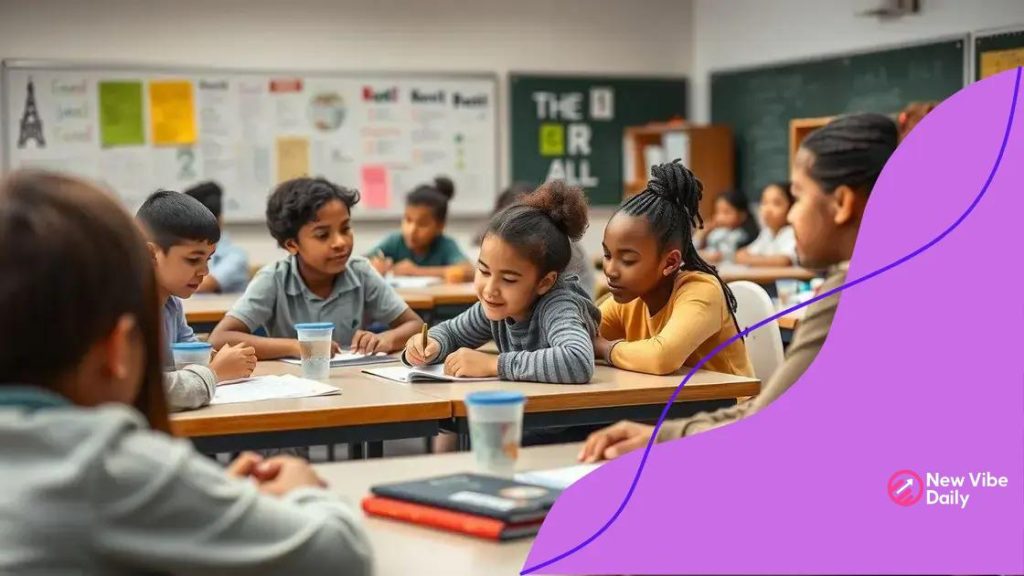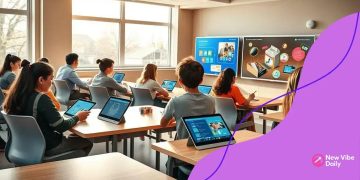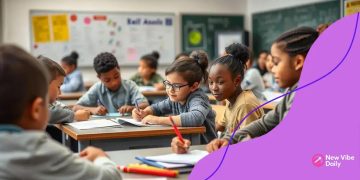Post-pandemic education reforms: what to expect next

Post-pandemic education reforms focus on integrating technology, supporting emotional well-being, and ensuring equity to create more engaging and inclusive learning environments for all students.
Post-pandemic education reforms are reshaping the landscape of learning as we know it. Have you ever wondered how these changes will enhance accessibility and foster innovation in schools? Let’s dive into the transformative trends at play.
The impact of the pandemic on education systems
The COVID-19 pandemic has significantly shifted the landscape of education, affecting how students learn and teachers teach. Many schools had to transition to remote learning almost overnight, which brought numerous challenges and opportunities for improvement.
Challenges Faced by Students and Teachers
During the initial lockdowns, many students struggled with accessibility to technology and the internet. This issue highlighted the existing disparities in education. In many cases, teachers were not adequately trained to deliver effective online instruction. As a result, both students and educators faced steep learning curves.
- The digital divide made learning less effective for some students.
- Teachers had to adapt their teaching styles rapidly.
- Parents became more involved in their children’s education.
- Student engagement in online formats often dropped.
The impact of the pandemic forced educational institutions to rethink their strategies. Schools began to implement more flexible learning environments to accommodate different learning styles and scenarios.
Opportunities for Innovation
On the brighter side, the challenges led to significant reforms and innovations. Schools started exploring various digital tools and resources to enhance the learning experience. This exploration opened doors to diverse educational materials and platforms that cater to many learning preferences.
As we move forward, the integration of technology in classrooms is expected to become even more prevalent. Hybrid models of learning, where students combine in-person and online experiences, are likely to become a norm.
Although the pandemic posed many difficulties, it also served as a catalyst for positive change in education. The focus is now on fostering adaptability and resilience among students and teachers alike, paving the way for a more inclusive and innovative educational future.
Key reforms reshaping learning experiences
Recent reforms in education are significantly changing the way students learn. As schools adapt to new challenges, several key changes are emerging that enhance the overall learning experience.
Flexible Learning Environments
One major reform is the shift toward flexible learning environments. This approach allows students to choose their learning style, whether it be online, in-person, or a mix of both. Such flexibility caters to various learning preferences and needs, making education more accessible.
- Students can learn at their own pace.
- Different formats promote greater engagement.
- Collaboration becomes easier through diverse platforms.
- Increased focus on individualized learning plans.
Moreover, schools are incorporating collaborative tools that enable students to work together remotely. These tools foster communication and help build a sense of community, even when learning takes place at a distance.
Emphasis on Social-Emotional Learning
Another important aspect is the growing emphasis on social-emotional learning (SEL). This approach prioritizes students’ emotional well-being alongside academic growth. Educators are trained to recognize the mental health needs of their students and create supportive environments.
As learners return to classrooms, SEL practices help students adjust, providing them with coping strategies. Understanding and managing emotions has become a key component of education, enhancing student resilience and performance.
Overall, these reforms aim to create more inclusive, engaging, and supportive educational experiences, preparing students for both academic success and personal growth.
How technology is driving educational change

Technology is a key player in reshaping education today. Its influence can be seen in classrooms worldwide, promoting new ways of learning and teaching. With advanced tools, students gain greater access to information and learning resources.
The Role of Digital Tools
One major change is the integration of digital tools in everyday learning. Schools are increasingly adopting technologies like learning management systems (LMS), educational apps, and virtual classrooms. These tools help enrich the learning experience.
- Students can access coursework anytime, anywhere.
- Interactive apps make learning fun and engaging.
- Teachers can track student progress easily.
- Collaboration is enhanced through shared online platforms.
While these tools offer many benefits, they also require proper training for teachers to use them effectively. Educators are adapting to these innovations, finding creative ways to enhance lessons and facilitate discussions.
Online Learning and Resources
The rise of online learning platforms has also transformed education. Websites and applications like Khan Academy and Coursera provide students with additional resources that complement their classroom learning. This accessibility allows for self-paced study and personalized learning paths.
Many students are taking advantage of these platforms to explore subjects beyond the traditional curriculum. Furthermore, aspects of virtual reality (VR) and augmented reality (AR) are beginning to create immersive learning experiences, making complex subjects easier to understand and more engaging.
As technology continues to evolve, its impact on education is becoming more profound. It fosters innovative teaching methods and opens up a world of possibilities for students and educators alike.
The role of teachers in post-pandemic classrooms
In post-pandemic classrooms, teachers play a crucial role in navigating a transformed educational landscape. Their adaptability and creativity are essential as they implement new strategies to engage students, making learning effective and enjoyable.
Adapting to New Teaching Methods
Teachers are embracing a variety of teaching methods that cater to diverse learning styles. With the introduction of hybrid learning models, educators are combining in-person and online teaching to enhance accessibility.
- Utilizing technology to facilitate interactive lessons.
- Creating personalized learning experiences for each student.
- Encouraging collaboration through group projects, both in and out of the classroom.
- Implementing assessments that reflect individual progress.
By incorporating these methods, teachers can better engage students who may struggle in traditional settings, ensuring that everyone receives the support they need.
Fostering Emotional Support
Beyond academic instruction, teachers now focus on providing emotional support to their students. The pandemic highlighted the importance of mental health in education, prompting educators to create safe spaces for students to express themselves.
Teachers are integrating social-emotional learning (SEL) into everyday activities, helping students build resilience and cope with anxiety. Through open conversations and activities that promote empathy, teachers foster a sense of belonging in their classrooms.
As education continues to evolve, the role of teachers will remain vital in shaping supportive learning environments. Their dedication to both academic and emotional growth equips students with the skills they need for the future.
Future challenges and opportunities in education
The future of education holds both challenges and opportunities that will shape the way students learn and educators teach. As we adapt to a world transformed by recent events, it’s essential to recognize the factors that will influence the educational landscape.
Emerging Technologies
One significant opportunity lies in emerging technologies such as artificial intelligence (AI) and machine learning. These technologies can personalize learning experiences, providing customized content and assessments that cater to individual student needs. As schools adopt these innovative tools, students can learn more effectively.
- AI can help identify students’ strengths and weaknesses.
- Learning platforms will become more tailored to user behavior.
- Data analytics will allow teachers to track progress in real-time.
- Virtual and augmented reality can create immersive learning environments.
However, integrating these technologies requires investment in infrastructure, training for educators, and access for all students.
Equity in Education
Another ongoing challenge is ensuring equity in education. As technology becomes more integral, the gap between those who have access and those who do not may widen. Schools must address these disparities to provide equal opportunities for all learners.
Community partnerships and funding initiatives will play a crucial role in improving access to technology and resources. By promoting inclusivity, schools can create a more equitable environment that benefits every student.
As we look ahead, adapting to change will be vital. Educators, policymakers, and communities must work together to overcome obstacles while embracing the opportunities presented by new technologies and approaches.
The future of education is filled with exciting challenges and opportunities. As we embrace new technologies and teaching methods, we can create more inclusive and engaging learning environments. It’s essential for educators and communities to work together to ensure all students have access to the resources they need. By focusing on equity, supporting emotional well-being, and leveraging innovative tools, we can prepare students for success in a fast-changing world. Ultimately, the goal is to foster growth and resilience among learners, guiding them to thrive in their educational journeys.
FAQ – Frequently Asked Questions about Post-Pandemic Education Reforms
What are some benefits of technology in classrooms?
Technology enhances learning by providing personalized resources, facilitating collaboration, and making education more accessible for all students.
How can teachers support emotional well-being?
Teachers can promote social-emotional learning by creating safe spaces for students to express feelings and encouraging discussions about mental health.
What challenges does equity in education pose?
Equity challenges include the digital divide, where not all students have access to technology, making it essential to address these gaps for equal opportunities.
How can schools adapt to future educational changes?
Schools can remain adaptable by continuously incorporating new technologies, improving teaching methods, and maintaining open communication with students and parents.






